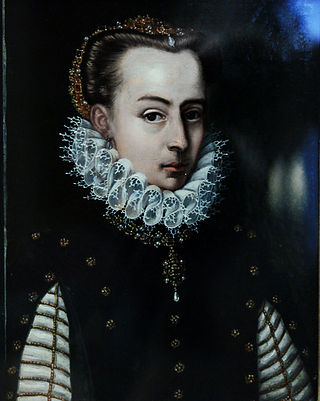Catarina of Portugal, Duchess of Braganza
Claimant to the Portuguese throne in 1580 From Wikipedia, the free encyclopedia
Infanta Catherine of Portugal, Duchess of Braganza by marriage (Portuguese: Catarina; Portuguese pronunciation: [kɐtɐˈɾinɐ], 18 January 1540 – 15 November 1614)[1] was a Portuguese infanta (princess) claimant to the throne during the Portuguese succession crisis of 1580.
| Catherine | |
|---|---|
 | |
| Born | 18 January 1540 Lisbon, Portugal |
| Died | 15 November 1614 (aged 74) Vila Viçosa, Portugal |
| Spouse | |
| Issue among others... | Teodósio of Braganza |
| House | Aviz |
| Father | Duarte, Duke of Guimarães |
| Mother | Isabel of Braganza |
| Religion | Roman Catholicism |
Biography
Summarize
Perspective
Background
Catherine was the second daughter of Duarte, Duke of Guimarães (sixth son of Manuel I of Portugal) and Isabel of Braganza. On 6 December 1563, she married João I, Duke of Braganza,[2] head of the most powerful aristocratic house in Portugal. The two were first cousins.[3]
Succession crisis
Following the death of young King of Sebastian of Portugal in the Battle of Alcácer Quibir, his great-uncle Henry I of Portugal succeeded to the throne.[4] Elderly and bound to ecclesiastical vows, Henry could not produce a direct heir, leading to much deliberation over his successor during his short reign.[5] Catherine was Henry's preferred successor, but because of her sex, the powerful influence of Philip II, and the unpopularity of her husband, she failed to garner popular support.[6] Her main rivals were António, Prior of Crato, the male-line but illegitimate grandson of Manuel I, and Philip II of Spain, the son of Manuel's eldest daughter.
In February 1579, King Henry summoned the candidates to submit their claims to a panel of jurists. António's swift dismissal as a result of illegitimacy left only Philip II and Catherine in formal contention.[7] Catherine’s descent through a male line, as the daughter of Manuel's youngest son, Duarte, offered her precedence over Philip.[8] The heir by primogeniture was Catherine’s nephew Ranuccio Farnese,[a] being the son of her late older sister Maria,[10] followed by his siblings; then the Duchess herself and her children; and only after them, King Philip.[11] Although Philip lacked legal arguments, he wielded immense power and influence over the Portuguese aristocracy, securing their support through bribery and coercion.[12]
Philip even tried to bribe Catherine's husband, the Duke of Braganza, to abandon his wife's pretensions, offering him the Vice-Kingdom of Brazil, the post of Grand-Master of the Order of Christ, a license to send a personal ship to India every year, and the marriage of one of his daughters to Diego, Prince of Asturias, Philip's heir at that time. The Duke of Braganza, influenced by Catherine, refused the proposal.[13]
Despite António being formally eliminated, his popularity overshadowed Catherine's.[14] Portugal had not yet seen an undisputed queen regnant and there were doubts about a woman's ability to effectively rule.[15] In this regard, her prospects should have been bolstered by having a husband with direct royal lineage with whom she could share sovereignty and a son, Teodósio, that would serve as heir and successor to the throne.[16] However, the Duke of Braganza's perceived weak leadership and widespread unpopularity compounded by Teodósio's absence[b] only weakened Catherine's candidacy further.[18]
King Henry died in January 1580 without having appointed a successor, leaving a regency of five governors to assume power while the panel continued to deliberate.[19] António promptly sought to claim the throne through popular acclamation in Lisbon, while Catherine and her husband adopted a more cautious stance, awaiting the findings of Henry's panel of jurists. In the interim, Philip, growing impatient, initiated military preparations, dispatching the Duke of Alba to assert Portugal by force. Eventually, the Braganzas succumbed to Philip's military pressure.[20] After defeating António in the brief War of the Portuguese Succession, Philip was recognized as King of Portugal by the Cortes of Tomar in 1581.[21]
Legacy
In 1640, Catherine's grandson and direct heir, the then 8th Duke of Braganza, was proclaimed King John IV of Portugal by the Portuguese nobility, marking the end of the 60-year-old Iberian Union and establishing the House of Braganza on the Portuguese throne.[22] The 'laws of Lamego' were used to justify his accession and designate the Spanish Habsburg king, Philip III of Portugal, a usurper.[23]
These laws, purportedly enacted by the Cortes of Lamego in 1143 but now widely accepted to be fictitious,[24] asserted that no woman that married a foreign prince could inherit the Portuguese crown or transfer succession rights.[25] This excluded both Philip II and Ranuccio Farnese from the succession, rendering Catherine the legitimate heiress.[23]
Issue
Catherine and her husband had the following children:[citation needed]
- Maria of Braganza (1565–1592).
- Seraphina of Braganza (1566–1604), married Juan Fernandez Pacheco, 5th Duke of Escalona, and had issue.
- Teodósio of Braganza (1568–1630), succeeded his father as Duke of Braganza; father of King John IV of Portugal.[17]
- Edward of Braganza, 1st Marquis of Frechilla.
- Alexander of Braganza, Archbishop of Évora.[2]
- Cherubina of Braganza (1572–1580).
- Angelica of Braganza (1573–1576).
- Isabella of Braganza (1578–1582).
- Philip of Braganza (1581–1608).
Ancestry
| Ancestors of Catarina of Portugal, Duchess of Braganza | |||||||||||||||||||||||||||||||||||||||||||||||||||||||||||||||||||||||||||||||||||||||||||||||||||||||||||||||||||||||||||||||||||||||||||||||||||||||||||||||||||||||||||||||||||||||||||||||||||||||||||||||||||||||||||||||||||||||||||||||||||||||||||||||||||||||||||||||||||||||||
|---|---|---|---|---|---|---|---|---|---|---|---|---|---|---|---|---|---|---|---|---|---|---|---|---|---|---|---|---|---|---|---|---|---|---|---|---|---|---|---|---|---|---|---|---|---|---|---|---|---|---|---|---|---|---|---|---|---|---|---|---|---|---|---|---|---|---|---|---|---|---|---|---|---|---|---|---|---|---|---|---|---|---|---|---|---|---|---|---|---|---|---|---|---|---|---|---|---|---|---|---|---|---|---|---|---|---|---|---|---|---|---|---|---|---|---|---|---|---|---|---|---|---|---|---|---|---|---|---|---|---|---|---|---|---|---|---|---|---|---|---|---|---|---|---|---|---|---|---|---|---|---|---|---|---|---|---|---|---|---|---|---|---|---|---|---|---|---|---|---|---|---|---|---|---|---|---|---|---|---|---|---|---|---|---|---|---|---|---|---|---|---|---|---|---|---|---|---|---|---|---|---|---|---|---|---|---|---|---|---|---|---|---|---|---|---|---|---|---|---|---|---|---|---|---|---|---|---|---|---|---|---|---|---|---|---|---|---|---|---|---|---|---|---|---|---|---|---|---|---|---|---|---|---|---|---|---|---|---|---|---|---|---|---|---|---|---|---|---|---|---|---|---|---|---|---|---|---|---|---|---|---|
| |||||||||||||||||||||||||||||||||||||||||||||||||||||||||||||||||||||||||||||||||||||||||||||||||||||||||||||||||||||||||||||||||||||||||||||||||||||||||||||||||||||||||||||||||||||||||||||||||||||||||||||||||||||||||||||||||||||||||||||||||||||||||||||||||||||||||||||||||||||||||
Notes
- Rannucio's claim was not pressed because his father, Alessandro Farnese, Duke of Parma, was an ally of Philip II.[9][10]
- Following his participation in the Battle of Alcácer Quibir alongside King Sebastian, young Teodósio's return home was intentionally delayed by Philip during the succession crisis.[17]
References
Wikiwand - on
Seamless Wikipedia browsing. On steroids.
